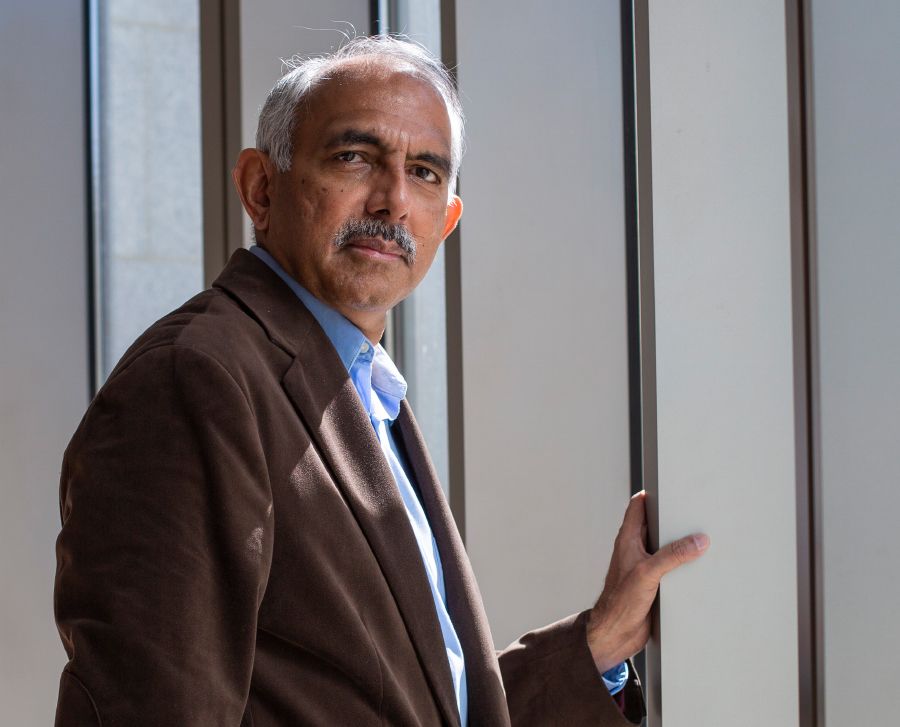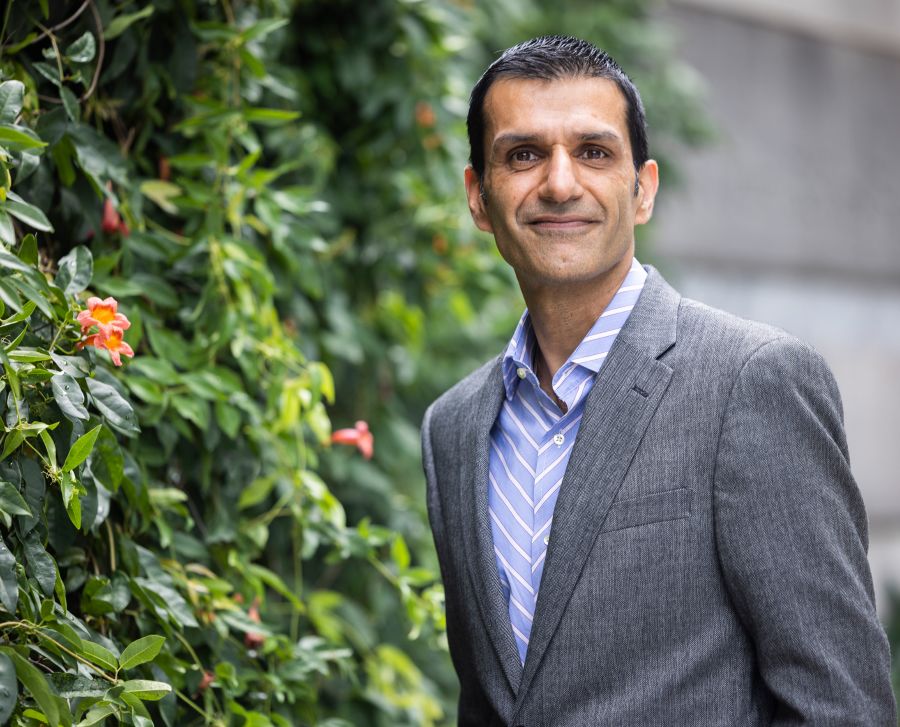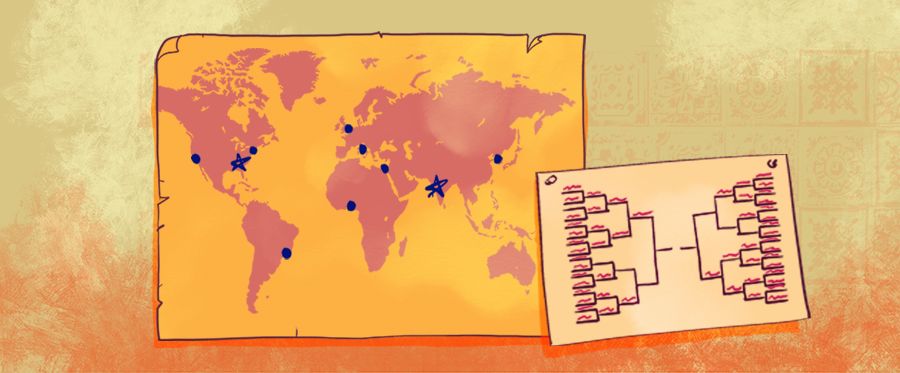DEFEATING DIABETES
Emory’s global approach to researching the disease—a growing pandemic that affects more than a half-billion adults worldwide—is opening new ways to prevent, treat, and potentially eradicate it.

DEFEATING DIABETES
Emory’s global approach to researching the disease—a growing pandemic that affects more than a half-billion adults worldwide—is opening new ways to prevent, treat, and potentially eradicate it.
K.M. Venkat Narayan helped write the playbook for fighting diabetes at the Centers for Disease Control and Prevention (CDC). It’s a familiar public health mantra—exercise, diet, weight control, and medication if necessary. So it stood to reason that he would fall back on the advice he had created when Emory University recruited him to start the Global Diabetes Research Center at the Rollins School of Public Health some 15 years ago.
But in the center’s first project abroad in India, where Narayan was born and raised, he discovered that this prescription in fact didn’t work for everyone.
“My assumption at the time was that whatever we had learned in the United States and Europe would work elsewhere,” says Narayan, who serves as the Ruth and O.C. Hubert Chair in Global Health at Rollins. “I believed that we could extrapolate that knowledge in India or Africa or wherever. The sobering fact is that you cannot. I remember with great embarrassment some of the talks I gave in India from 2007 to 2009. I was proselytizing the role of obesity in diabetes, which is what we did in the US, but we realized over time that we were dealing with something more complicated and possibly different.”

K.M. Venkat Narayan is the co-director of the Emory Global Diabetes Research Center and Ruth and O.C. Hubert Chair in Global Health at Rollins.
K.M. Venkat Narayan is the co-director of the Emory Global Diabetes Research Center and Ruth and O.C. Hubert Chair in Global Health at Rollins.
Many people in India were developing diabetes at earlier ages than patients in the US and without being particularly overweight. Diabetes, it appeared, was even more complicated than the worldwide authorities on the disease realized.
The center that Narayan founded was set up to investigate and prevent one of the fastest-growing chronic diseases on the planet. More than half a billion adults have diabetes, and the International Diabetes Foundation projects that number will swell to three-quarters of a billion by 2030.
Diabetes is, in all regards, a noncommunicable pandemic—one that resides at the intersection of globalization, economics, and health care.
The center has grown with the problem, expanding from one researcher in 2008 to more than 150 faculty and staff members in 2022, spread across schools and departments at Emory, as well as at partnerships institutions Georgia Tech and the Morehouse School of Medicine in Atlanta. During that time, the center also has forged partnerships with eight major research universities and institutions total. And it now holds investigative partnerships in 21 countries on six continents, with an emphasis on research in South Asia and Africa.
“There are plenty of diabetes centers around the U.S., but we’re the only one with such a global focus,” says center co-director Mohammed K. Ali, William H. Foege Distinguished Professor of Global Health at Rollins.

Mohammed K. Ali is the co-director of the Emory Global Diabetes Research Center and Foege Professor of Global Health at Rollins.
Mohammed K. Ali is the co-director of the Emory Global Diabetes Research Center and Foege Professor of Global Health at Rollins.
Not that the center doesn’t address diabetes in Georgia. Far from it. With funding from the National Institutes of Health, the center founded the Georgia Center for Diabetes Translation Research with Georgia Tech and the Morehouse School of Medicine to investigate the role of healthcare equity in preventing and managing the disease.
“Georgia is in the middle of the diabetes belt,” Narayan says. “We have counties in the state where the life expectancy is as low as Mongolia or North Korea. What this means is that even though we have all this great science available, our delivery systems are lacking. We’re studying ways to narrow the gap and improve equity.”
In acknowledgement of the worldwide crisis—and the need for a more expanded role—Emory earlier this year gave the center an administrative promotion, realigning it to report directly to the Woodruff Health Sciences Center. The move gives it a more prominent place alongside the Winship Cancer Institute, the Emory Brain Health Center, and other efforts with a university-wide footprint.
It also means the Emory Global Diabetes Research Center—as it’s now known—will receive greater funding and higher visibility.
“Through our global research so far, we’ve established that diabetes is a far more complex disease than originally thought, and that it affects different populations in very different ways,” says Jonathan S. Lewin, the longstanding Woodruff Health Sciences executive vice president for health affairs who recently stepped down. “By elevating the center, Emory can broaden its approach to understanding, preventing, managing, and ultimately curing a disease that affects hundreds of millions of people globally.”
Adds Narayan: “It gives us a path to widen our scope. There’s so much we still need to learn about the disease.”
One of the biggest mysteries is why diabetes presents such a different face in developing countries like India. The answer will almost certainly have implications for people in all countries—big and small, rich and poor.

LEADERS TRAIN FOR THE FIGHT
Venkat Narayan didn’t set out to study diabetes. Growing up in Bengaluru, in southern India, he didn’t think much about the disease during his youth in the 1960s because it seemed to afflict so few people.
After finishing medical school, Narayan moved to the United Kingdom for his clinical residency and grew interested in epidemiology. He took a tenured position at the National Health Service and a senior lectureship at the University of Aberdeen. He thought he and his wife, Asha Krishnaswamy, a computer scientist, would live in Scotland for the rest of their lives.
But his career detoured after he co-wrote a paper about cardiovascular disease among Scots and its link to diabetes. The paper attracted attention, and he was invited to an international diabetes course in Cambridge, where he met many of the world’s leading experts on the disease
One thing led to another, and Narayan soon found himself in the US working with the National Institutes of Health on a major investigation of diabetes among the Pima Indians of Arizona. That work, in turn, led him to Atlanta and the CDC, where he was hired to lead the diabetes branch and to help create a nationwide prevention and control program.
“There wasn’t a lot of diabetes intervention and prevention work being done before the 1990s,” he says. “The approach was: You either had it or you didn’t.”
The recognition of pre-diabetes—and the existence of a large population who could postpone or avoid the disease with lifestyle changes—at the CDC revolutionized the field. It showed that diabetes wasn’t an either-or proposition but a continuum that changes with age. And it was one of the biggest developments in diabetes research since the discovery of insulin, the hormone that regulates glucose, in a Toronto lab in 1921. Narayan and colleagues at the CDC also developed strategies and approaches for system-wide improvements in diabetes quality of care, something that has resulted in major declines in diabetes mortality and complications.
After a decade with the CDC through the early 2000s, Narayan came to Emory to head up the diabetes research center. In fact, in the beginning, he pretty much was the center.
“We had little data and hardly any funding,” recalls one of his first hires, Solveig Cunningham, a professor of global health at Rollins who specializes in demographics and sociology. “One of the cool things about Venkat is the way he thinks outside the box. You would have expected him to bring in diabetes experts, but he wanted to bring in people with different skills and expertise and let them engage with diabetes. I had never worked with diabetes before I joined the center. All my work had been on childhood health.”
Another early recruit was Ali. A South Asian like Narayan, Ali is Pakistani but grew up in Africa, where his father moved as an expatriate. When he finished medical school in South Africa and won a Rhodes scholarship, Oxford University in the UK offered him two subjects for cardiovascular study—one focused on animals and the other centering on the links between obesity and diabetes.
He opted for the second, largely because of his family history. His mother was diabetic and he had been overweight as a teenager.
“When I was 16, I was shorter and weighed 25 or 30 pounds more than I do now,” Ali says. “It was because of poor habits.”
During his time at Oxford, Ali heard a speaker from Atlanta, Jeffrey Koplan, a former CDC director who had become vice president for global health at Emory. He told the young Rhodes scholar about the diabetes research center Emory was starting and suggested he contact the founding director. Fourteen years later, Ali was named co-director of the center and Foege Professor.
“We tinkered with our brand the first few years,” Ali says. “We weren’t sure how much we should stress the global aspect. We thought that might be a liability. But it was too important to our identity.”
As it turned out, that global focus led to some of the center’s most important discoveries.

No Borders Respected
During the COVID-19 pandemic, doctors and epidemiologists repeatedly emphasized that infectious diseases respect no borders. The same could be said of noninfectious chronic diseases. The forces of modernization that have driven the growth of diabetes—more sedentary lifestyles and an abundance of refined convenience foods, among others—don’t stop at borders either.
When the center began, Narayan says, diabetes research was grossly imbalanced. Low- and middle-income countries accounted for 80 percent of people with the disease worldwide, yet almost all the investigations had involved populations in richer countries in Europe and North America. There was a glaring need for broader and more diverse research.
The center focused on India, where Narayan had many contacts. It has since undertaken 24 research projects in the country, where diabetes has been growing at an alarming rate. The center works with long-term local research partners, careful to treat them as full collaborators.
“We have worked with Venkat and others at Emory for years,” says Nikhil Tandon, head of the endocrinology department at the All India Institute of Medical Sciences. “The relationship is built on dialogue, understanding of local contexts and perspectives, and on occasion even agreeing to disagree. Communications are frank but built on logic and reason.”
The longest-running project is the CARRS Cohort—CARRS stands for Cardiovascular Risk Reduction in South Asia—which has followed the health of 22,000 people in two Indian cities since 2010. Narayan thinks of it as a study of the natural history of diabetes and its complications. It’s more than four times larger than one of the best-known longitudinal studies in medical history, the Framingham Heart Study, which tracked 5,209 adults in Framingham, Mass., starting in 1948, and found that high blood pressure and cholesterol were risk factors for cardiovascular disease.
CARRS is already yielding a similarly significant realization about diabetes. It isn’t just two diseases: Type 1, the less prevalent variety that used to be known as juvenile diabetes; and Type 2, the more common condition associated with obesity and aging—what used to be known as adult-onset diabetes. Instead, it’s actually a spectrum of diseases or multiple phenotypes.
Narayan and others at the center first reached this insight by noticing that many people with diabetes in India were younger and not obese.
“They didn’t really look like many of the people with diabetes you see in the US,” says Mary Beth Weber, an assistant professor of global health and epidemiology at Rollins who worked with one of the center’s prevention programs in India. “They looked like they didn’t need to lose weight.”
Narayan and his research partners theorized that they were seeing a new form of diabetes. In the West, most people develop the disease because their bodies, with age and obesity, grow resistant to the insulin their pancreas produces. In India, the researchers proposed, the problem was that the pancreas wasn’t producing enough insulin to begin with.
In essence, there were at least two forms of Type 2 diabetes: insulin-resistant and insulin-deficient. The question is why.
“This is the heart of where our research is going,” Narayan says. “There are a pair of clues so far. One is that 90 percent of the world missed the industrial revolution and is still recovering from many decades of relative undernourishment. Perhaps their bodies adapted for survival.”
The second clue? Narayan says that the endocrine part of the pancreases in India appear significantly smaller compared than ones in Western countries. It’s possible they’re unable to secrete as much insulin. Narayan and colleagues like Rollins assistant professor Lisa Staimez are in the process of establishing a pancreatic biobank in India in collaboration with similar biobanks in the US.
Wherever the research leads, Narayan believes the US has as much to learn about diabetes from India as the other way around. Insulin-deficiency occurs in Americans as well, just not as often, and the new research can help in treating it.
“We also have a lot to learn about how to manage diabetes at scale and at a lower cost,” he says. “In India, they’re forced to manage diabetes at a fraction of the cost we do. Perhaps we could adapt parts of that system and deliver it to a population in, say, Georgia and save money?”

WINS AND LOSSES IN A COMPLEX BATTLE
The outlook for diabetes is getting both better and worse at the same time. Treatment and prevention of the disease is better than it has ever been. As a result, the death rate from diabetes has declined in developed countries in North America and Europe.
But simultaneously, medical expenditures associated with the disease have risen.
Diabetes is notorious for causing health complications throughout the body, from vision and kidney failure to stroke, heart disease, and amputations. With so many debilitating consequences, it’s no surprise that the Centers for Medicare and Medicaid Services says diabetes is the single biggest contributor to its rising costs.
The ominous news is that the diabetes pandemic will almost certainly get worse before it gets better. Projections show the disease afflicting a rising percentage of the global population for the foreseeable future.
“I wish I could say it’s leveling off in the US, but I can’t,” Ali says. “We have all this information about how to prevent and mitigate diabetes, but we just haven’t been able to engage people to make enough of the changes they need to make. We’re not getting a shift in the broader population on obesity, and thus not on diabetes, either.”
The Emory Global Diabetes Research Center today studies diabetes on dual fronts: 1) investigating the disease itself and 2) exploring better ways to prevent and treat it. It’s a wide-ranging approach that considers everything from health equity and access disparities to the effect of toxins and pollution on the pancreas.
“We are an ecosystem of interdisciplinary diabetes research that runs from basic science to epidemiology to clinical trials to translation sciences and health technology,” Narayan says.
One promising research frontier is the role of artificial intelligence (AI) and data mining. Joyce C. Ho, an associate professor of computer science, came to the center in 2017 to test whether data could improve prevention and treatment of a chronic disease.
“Amazon, Target, and Walmart can make good recommendations to individuals about products they might like to buy based on the information they gather online,” she says. “Why can’t we do the same thing when it comes to preventing diabetes? Why can’t we layer information about your environment and suggest better ways for you to eat and exercise. These social determinants of health are so important.”
Ho isn’t sure exactly how it will manifest, but she believes AI has the potential to revolutionize the field. “When insulin was discovered 100 years ago,” she says, “it transformed diabetes care. AI could transform diabetes care as much as insulin. I could see it starting to happen in the next five years.”
Ali believes data mining could be just as transformative in allowing doctors to target diabetes treatment more precisely.
“The more layered information we process together, the better we’ll be able to match people with interventions that work for them,” say Ali. “This is a nascent science, and there are few actual trials, but we’ve seen enough to signal that’s it’s worth pursuing. And it doesn’t hurt that Emory is investing heavily in artificial intelligence.”
Like cancer, diabetes is a disease that was once thought of in monolithic and almost unapproachable terms. But as researchers’ thinking has been fine-tuned, the disease’s complexities may actually hold solutions for fighting it more precisely and effectively.
“It’s human nature to oversimplify things,” Ali says. “We did that with diabetes. But now that we know that it’s much more complicated, we’re not looking for a silver bullet that works for everyone. We’re looking for the bullet that works for you as an individual—this is precision medicine and precision public health.”
Written by Jim Auchmutey. Illustration by Charlie Layton. Photography by Kay Hinton. Design by Elizabeth Hautau Karp.
A DISEASE OF STAGGERING IMPACT
These statistics prove without a doubt that diabetes is a pandemic of epic proportions that affects hundreds of millions of lives every day in a variety of ways.
Worldwide Impact: 537 million adults have diabetes. The number is projected to reach 643 million by the end of the decade. Three in four adults with diabetes live in low- and middle-income countries.
In the United States: 11.3% of the nation’s population has diabetes, a 42% increase in the past 10 years. The U.S. has the highest diabetes rate among developed nations.
Age: 48.8% of Americans over 65 have diabetes or prediabetes.
Ethnicity: 14.5% of American Indians and Alaska natives have diabetes, 12.1% of non-Hispanic Blacks, 9.5% of non-Hispanic Asians, and 7.1% of non-Hispanic whites.
Education: 13.4% of those who didn’t finish high school have diabetes, 9.2% of those with a high school diploma, 7.1% of those with some higher education.
Economics: Diabetes is associated with $327 billion a year in direct healthcare expenditures and lost productivity in the U.S. Worldwide, 11.5% of all health resources globally, approximately $966 billion annually, are spent on diabetes.
Mortality: Diabetes is the seventh leading cause of death in the U.S. Worldwide, diabetes is associated with 6.7 million million deaths annually.
Sources: Centers for Disease Control and Prevention, American Diabetes Association, International Diabetes Foundation.

Want to know more?
Please visit Emory Magazine, Emory News Center, and Emory University.

